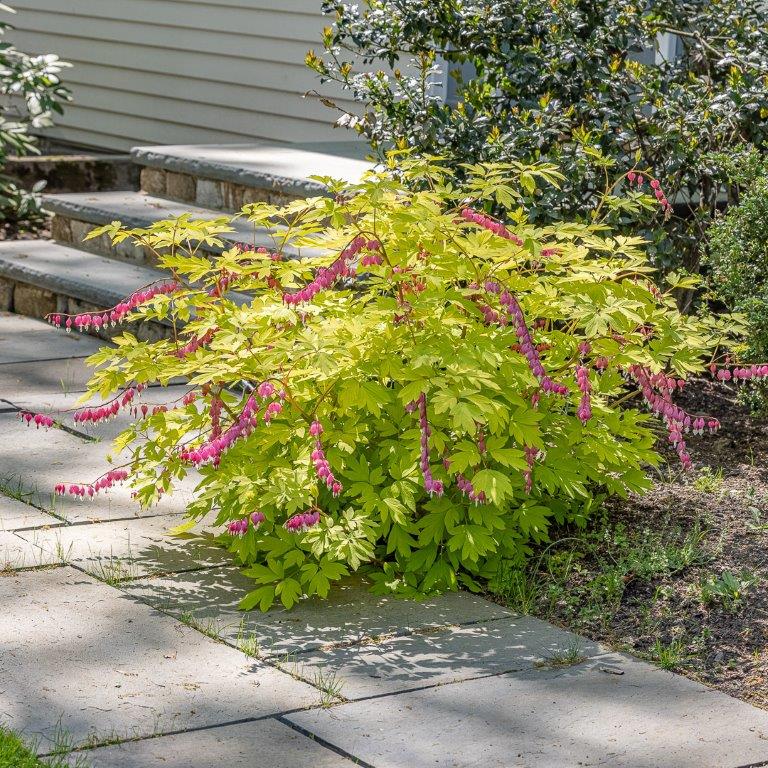Bleeding heart (Lamprocapnos spectabilis or formally known as Dicentra spectabilis) is a tried-and-true shade-loving perennial staple in many gardens. It has lovely pinkish heart-shaped blooms that last for weeks and grows in the shade to part sun and reaches up to 3 feet tall and wide. Bleeding hearts humus-rich, moist, but well-drained soils and don’t do well in damp sites. They can handle full sun in colder regions and dry soils for a period, but they go dormant in the summer when things tend to dry out anyway. Bleeding heart is an excellent plant for woodland gardens and shaded rock gardens that help to accentuate its arching floral display. There is a pure white flowering version’ alba’ that is beautiful as well. They go dormant in the summer after blooming, so don’t be alarmed when their foliage turns yellow and dies as it will return the following spring.
| Key Details | |
|---|---|
| Common Name: | Bleeding heart |
| Botanical Name: | Lamprocapnos spectabilis or Dicentra spectabilis |
| Plant Type: | Perennial |
| Plant Description: | Spring-blooming perennial with arched steps holding rows of pink heart-shaped flowers. |
| Height: | 2’-3’ |
| Spread: | 2’-3’ |
| Foliage: | Green, turns yellow and dies by mid-summer |
| Flower: | Heart/pendant shaped beautiful and unique pink flowers |
| Bloom Time: | May |
| Site Conditions | |
| Climate: | Zones 3-9 |
| Soil Type: | Loamy. Moist well-drained soils are best. |
| Soil pH: | 6.0-6.5 |
| Soil Nutrients: | Low |
| Sun: | Full shade to part sun |
| Specific Conditions: | Windy sites may necessitate staking. Deer resistant. |
| Style | |
| Style Considerations: | The arching branches loaded with heart-shaped flowers are the main attraction with bleeding heart. The foliage and plant shape is nice, but since they go dormant in the summer, they are really planted for their long-lasting and unique floral display. They add some elegance to a garden, which makes them great early-season specimen plants. They fill out before many other perennials are just getting underway, so they can be used as an early spring focal point in an otherwise still-emerging landscape. |
| Maintenance | |
| Watering: | Watering weekly or biweekly if needed is typically best. Can handle some drought conditions. |
| Mulching: | Not required but always helps especially if you need to add organic matter to the soil. |
| Fertilizing: | Not needed if you have healthy humus-rich soil with plenty of organic matter. |
| Weeding: | Bleeding heart does a great job at stifling weeds since it gets established so early in the spring. Does die back midsummer opening a window for weeds. |
| Deadheading: | You can cut back the yellowing foliage once it yellows and falls to the ground when it starts to go dormant. |
| Staking: | Not needed, although the branches can break in heavy winds so consider hoop stakes if you have a windy site. The hoop stakes need to be installed in the early spring before the plant gets too big. |
| Dividing: | Yes, in early spring as they emerge or early fall |
| Transplanting: | Early spring when they start to appear or early fall is best but anytime works with sufficient watering. |
| Pruning: | See deadheading |
| Pests: | Powdery mildew, stem rot, slugs, aphids |
| Winterizing: | Cut back any stems that remain 2-3 inches above the ground after the first hard frost or two (when the ground freezes). You can also use straw or pile some leaves over the plants. |








